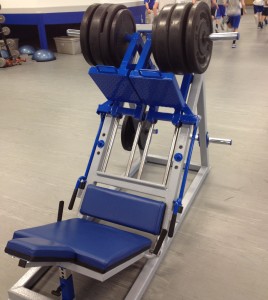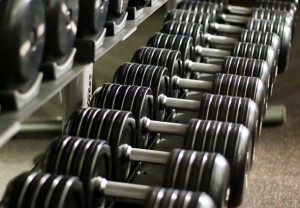Is one better than the other?
If you walk into any commercial gym these days, it will be filled with all sorts of different machines and free weights. Chances are, there is a different machine for every muscle in your body and a large array of dumbbells, barbells, kettlebells and other assorted pieces of free weight equipment that can target any muscle or movement you can think up. So the question is, which is best? Depending on who you talk to, you will find people claiming that using all machine weights is best, people claiming only using free weights is best and people in between saying a mixture of both is best. Let’s take a look at the difference between the two and find out which one is best for YOU.
Machine Weights
Overview
 Machine weights can generally be defined as an exercise machine that has a guided single motion movement such as a leg press machine or seated chest press machine. They are usually pin loaded or plate loaded to add resistance and can be either compound movements (multi joint) or isolation movements (single joint). These machines require little to no stabilization of the movement as the machine will guide the movement from start to finish.
Machine weights can generally be defined as an exercise machine that has a guided single motion movement such as a leg press machine or seated chest press machine. They are usually pin loaded or plate loaded to add resistance and can be either compound movements (multi joint) or isolation movements (single joint). These machines require little to no stabilization of the movement as the machine will guide the movement from start to finish.
Pros
• Bodybuilding & Physique – The lack of stabilization required to use a machine weight compared to a free weight exercise of the same movement means that there can be more focus on isolating the targeted muscles. This means the lifter can generally lift a heavier load putting more stress on the targeted muscles. It also makes it easier for the lifter to isolate specific muscles during the workout to help sculpt their desired physique.
• Ease of use – Machine weights are easier to use and they typically have pictures and diagrams on them to help understand how they are used. This can potentially be good for beginners or the elderly as it is far less intimating and may provide a stepping stone to more advanced exercises using free weights.
Cons
• Lack of core & joint stabilization – While bodybuilders and Physique models may benefit from machine weights, the lack of stability, coordination and core activation involved in these exercises means that there is far less of a carryover effect when it comes to sports and daily activities. This also means that you are training your body to go through certain movement patterns without the need for proper core integration or joint stability. This can lead to faulty movement pattern and will increase the risk of injury.
• Positional demands – Everybody has different body types, limb lengths, functional limitations and structural limitations. This means that the way I squat may need to be different to the way you squat and this applies to all movements. Machine weights don’t take this into account and can put your body into a position that doesn’t take into account your functional or structural limitations and can lead to unwanted injuries.
Free Weights
Overview
 Free weights can be considered as a piece of resistance equipment that is not fixed or restricted to a certain movement. There is now a huge array of different free weight equipment on the market that can train any movement or muscle group needed. They are dumbbells, kettlebells, barbells, weight plates, ropes, balls, bags, suspension training equipment like the TRX or gymnastics rings and even the cable machines as although they are a machine, they can be considered a fee weight as you have full control over the movement and need to stabilse the movement.
Free weights can be considered as a piece of resistance equipment that is not fixed or restricted to a certain movement. There is now a huge array of different free weight equipment on the market that can train any movement or muscle group needed. They are dumbbells, kettlebells, barbells, weight plates, ropes, balls, bags, suspension training equipment like the TRX or gymnastics rings and even the cable machines as although they are a machine, they can be considered a fee weight as you have full control over the movement and need to stabilse the movement.
Pros
• Functional Exercise – In short, functional exercise refers to doing exercises that are going to have a big carryover affect to your sport, daily activities or lifestyle. Free weights do this best by mimicking similar movements to your sport or lifestyle, for example if you’re a tennis player, doing a leg press machine and a chest press machine may work muscles needed for the sport but they also train the body not to need joint stability or core control. A better option would be multi directional lunges and a cable woodchop as these exercises put a much higher demand on stabilization and coordination while still targeting the required muscle groups and better mimicking the movements of the sport.
• Joint stability & core control – Free weight exercises typically require you to stand on your own two feet or sit/lie with a weight balanced above you without the support or assistance of a machine. This requires far greater activation of the core to maintain a stable torso and will require a greater degree of strength in the smaller stabilizing muscles of your joints. Imagine you were to only use free weights and build some bigger stronger legs and arms, sure you may look better now but you haven’t built any stability or core control to deal with the extra muscle. Now the next time you go to pick your kid up or go for a run outside with them, the chance of injury is far higher as you can’t stabilise your joints to deal with the extra strength you’ve built.
Cons
• Harder to use – Free weights do require a greater degree of knowledge and skill to use and for beginners this can be intimidating for some or lead to injuries for others. I would highly recommend seeking professional help from a trainer if you are new to the gym as they will teach you how to use them in a safe environment.
• Injuries – Free weights can be dangerous if they are used incorrectly and can lead to injury. It is advised that you educate yourself if you are unfamiliar with how to use free weights.
Conclusion
I like to say there is no such thing as a bad exercise, free weight or machine but there is such a thing as bad exercise application. In general I would recommend free weights mostly for the general population and sports athletes as this is going to have the best carryover affect in your sport or lifestyle. In saying that though, some people may benefit in strength from using a few machines as accessory work as long as they are doing enough free weight exercise to maintain adequate joint and core stability. As for machine weights, leave that for the bodybuilders and physique models who only require aesthetics and aren’t as concerned about athletic performance or movement.

Be sure that all products that are listed on the market have Federal Drug and
Administration approval.
Howdy I am so happy I found your weblog, I really found you by accident, while
I was browsing on Bing for something else, Anyways I am here now and would
just like to say thanks for a incredible post and a
all round enjoyable blog (I also love the theme/design), I don’t have time
to read through it all at the minute but I have saved it and also included your RSS feeds, so when I have time
I will be back to read much more, Please do keep up the great b.
You can personalize these with your name and logo and then it will be really hard to
miss your bag. there are some beautiful accessories out there that
do not have to cost a fortune. It’s better to ask for directions from more
legitimate places like stores or uniformed officers.
If you are consultant of Dudley Excavation, please take this time to replace your Excavating Contractor’s Profile.
This pressure is sufficiently maintained by the compressed air operated “spill valve. Cool outside air is drawn in through an open window and the hot stuffy air is moved outside. * The Illinois New Vehicle Buyer Protection Act, commonly known as the Illinois lemon law protects consumers who buy or lease new cars, pickup trucks, and vans in Illinois.
kmucutie freshwater & saltwater fishing lures, soft baits, hard baits, buzzbaits, lure kits big game fishign lures
I’ll immediately grab your rss feed as I can’t find your e-mail subscription link or e-newsletter service.
Do you have any? Kindly permit me recognize in order that I may just subscribe.
Thanks.
Excellent post. I was checking constantly this blog and I am inspired!
Very helpful info specifically the ultimate phase 🙂 I deal with such info
a lot. I was seeking this certain information for
a long time. Thanks and best of luck.
Excellent items from you, man. I’ve take into accout
your stuff prior to and you’re simply extremely excellent.
I actually like what you’ve bought right here, certainly like what you’re saying and the way during which you
are saying it. You are making it entertaining and you continue
to care for to keep it sensible. I can not wait to learn far more from
you. That is really a great web site.
Very shortly this web site will be famous among all
blog viewers, due to it’s good articles
Thanks for sharing, this is a fantastic post. Awesome. Maiga Warde Johnsson
Hi, after reading this amazing piece of writing i am also happy to share my know-how here with friends. Milo Kozuch